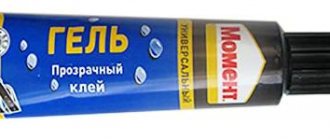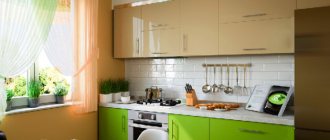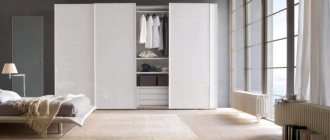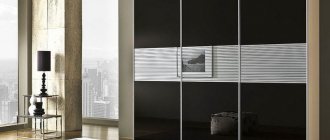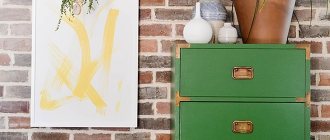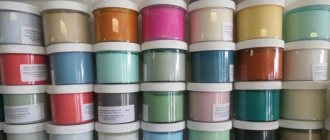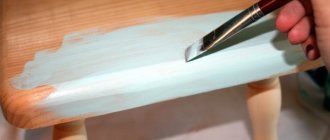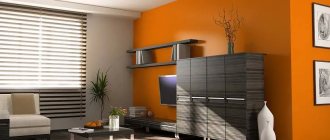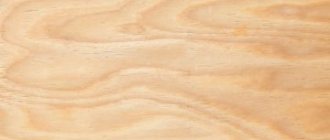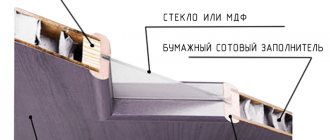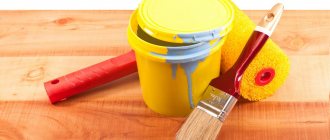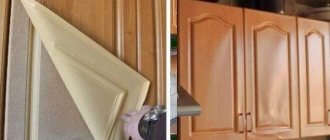Often, a wardrobe, a chest of drawers, or even all the furniture that has served us for many years, no longer meets the changed needs. They become unfashionable, do not match the color of new tiles or wallpaper, become boring and simply not pleasing. Of course, you can buy new ones, but not everyone is ready to spend a considerable amount on this. And old things, although not fashionable, familiar and comfortable, often have pleasant memories associated with them.
The best way out is to repaint them a different color. If successful, familiar things will not just get a second life, but will turn into a real element of the author’s design.
MDF boards of different shades
Is it possible to paint MDF furniture at home, how to paint MDF furniture at home, how to repaint MDF furniture with your own hands and what is needed for this - we will tell you below.
Should I choose gloss?
Today, there are a large number of options for decorating kitchens - it can be imitation of natural wood or stone, brass, patina, antique painting, various patterns.
When deciding between a matte and glossy finish, some people have doubts, because gloss is very easily soiled. They say that all the prints and stains are visible on it. In addition, the gloss of a bright shade may look “tacky”. Let's not lie - there is some truth in these statements. However, this is not a reason to give up gloss!
Of course, if you have a large family with small children, then painting MDF gloss monochrome black is not the best choice. Dark gloss is suitable for kitchens where cooking is not done very often.
Gloss in light shades is a good choice for any small kitchen, as such coatings visually expand the space. However, we would still recommend avoiding glossy countertops for reasons of practicality.
As for the “tackiness” of bright shades, you must agree that if you want something juicy, you don’t have to paint the entire kitchen in the “uncontrollable tomato” shade. You can choose a calmer burgundy or, for example, make the facades matte and restrained in color, and highlight the corners and transitions with a bright and rich gloss. By combining different textures you can achieve a very beautiful and unique effect.
What to combine with a glossy set?
Whatever you say, a glossy set, regardless of color, will stand out and attract attention.
Glossy MDF painting is undoubtedly an accent in the interior. It is better to surround it with discreet matte surfaces. This applies to the tabletop - it will also be more convenient, but it is especially important for the ceiling and floors.
A glossy set in combination with a glossy ceiling will not look as impressive as gloss on a matte background. The combined facades look interesting - the top is glossy and the bottom is matte. Or, for example, all horizontal surfaces are dark matte, and vertical surfaces are bright gloss.
The combination of a glossy finish with natural materials or their imitation looks interesting. Wooden details or a stone countertop will contrast very favorably with the brightness of the gloss.
Gloss MDF painting is a suitable choice for any modern design. It doesn’t matter whether it’s high-tech, loft, modern or fusion. By choosing the right color you can easily fit such furniture into the interior.
Base for a painted kitchen façade – material and requirements
Please note that MDF facades are painted
MDF is a medium density fiberboard. It, just like chipboard, is made from wood chips - that is, from wood processing waste. However, unlike cheap chipboard, natural resins are used to glue the chips. Therefore, MDF is considered an absolutely safe and environmentally friendly material.
It meets all the requirements for painted surfaces:
- the internal structure of MDF is homogeneous;
- has a smooth top side, without roughness and protruding pieces of chips;
- The porosity of the surface allows the primer and paint to be evenly distributed.
Technology of painting MDF with enamel.
The two most popular methods of covering facades. Firstly, this is painting MDF with enamel. Secondly, film coating. In this article we will look at the first method. Let’s make a reservation right away: this type of painting is for industrial conditions. High-quality glossy painting of MDF at home is very difficult.
Here we provide a short description of the technology used to paint MDF with enamel. The production process can take up to 10 days.
Preparatory stage.
- First, the surface is primed with an insulator. This is done in order to avoid raising the pile during subsequent sanding. It also prevents the enamel from sagging and being absorbed into the surface.
- After the first layer of primer has dried, use a sander to sand carefully so as not to damage the thin layer of primer.
- Next, a second primer is applied. White polyurethane painted MDF. This layer is needed for accurate color rendering. This layer dries up to a day.
- And again sanding. Using a sander with a P320-400 grit disc. Hard-to-reach areas are sanded by hand. After the first grinding, perform a second pass with a P400 wheel. This is done to achieve the best final result.
- If necessary, all chips and defects are filled with a one-component compound.
Application of enamel.
- Then the enamel is applied. Starting from the edge, moving to the main plane. An important point - professionals use only an industrial spray gun in their work. They apply both primer and enamel.
- It is impossible to achieve a high-quality result with a brush. On the Internet you can find tips on painting MDF with enamel using a spray can. We recommend using a spray gun. It is very important that the enamel application process takes place in a special room. Because dust, insects and tiny particles of dust can ruin the entire work.
- MDF painting is finished. Now apply varnish. Acrylic clear varnish is applied in two layers. The first layer dries - apply the second.
Finishing the product.
- Next, the façade is finally sanded, sprayed with water for cooling. Start with a grit of P1200-1500, gradually reaching a finish of P3000-4000. It would seem that only the final finishing of the product remains, but at this stage of painting MDF with enamel, the surfaces are uniformly matte.
- Polishing is the final stage of work, during which that magical glossy effect is achieved. Before polishing, the product is thoroughly dried. Depending on the specific materials on which the work was performed, after painting the facades dry for about two days. After final sanding, drying takes 5-7 days.
- The grinding machine at low speed applies abrasive paste to the entire surface of the product. And at high speeds, the actual polishing is carried out. First horizontally, then vertically. The result is a bright glossy effect.
- That's all! The product is packaged in foamed polyethylene and corrugated cardboard. These are “breathable” materials that allow chemical vapors to escape, which will continue to escape from the product for some time.
Please note that some unscrupulous companies use auto enamel for kitchen facades, claiming that it will be more beautiful. Painting MDF in the kitchen should be carried out only with specialized paint and varnish materials. Because they are safe and intended for direct contact with products!
Now you know what technology is used for glossy painting of MDF. We think that no one doubts that it is better to entrust this rather complex technological process to professionals. Call: +7 we will carry out coloring of any complexity in compliance with all technologies.
Why do this?
Many people wonder: is it possible to paint MDF at home, and why is this necessary? The answer to the first part of the question is yes. Indeed, you can paint the panels yourself. But it’s worth making a reservation right away: if you don’t have a spray booth at hand, the result is not always ideal. The coloring procedure is necessary for the following reasons:
- Painted elements become more resistant to high temperatures and humidity. Therefore, they can be used in the kitchen and bathroom, where they can fulfill different roles.
- By decorating, it is possible to diversify a dull interior and refresh the appearance of the room. The shade is chosen based on the design ideas.
- Painting MDF panels is also necessary in order to extend their service life.
Painting MDF allows you not only to diversify a boring interior, but also to extend the service life of the product
Of course, this option also has some disadvantages. For example, this procedure is sometimes much more expensive than using decorative films. In addition, the surface becomes prone to fading.
Scotch-Bright Bristle Brushes
| Rice. 24. Scotch-Bright Bristle brushes for sanding difficult terrains |
Scotch-Bright Bristle brushes are most suitable for sanding even-density wood species, MDF; in pine, grooves are obtained in soft wood of the early layers of annual rings.
How is molding painted professionally?
What are molded products and why is it better to paint them in a workshop? A walk-through painting machine for painting moldings, watch a video of its operation.
Source
- ← sanding linden for a bathhouse
- marble floor polishing estimate →
Selection of materials for painting
In principle, all paints for MDF are selected taking into account the composition of the material. And this is, first of all, a fine wood fraction, which means that paint solutions for wood are suitable for the job. But to obtain a truly high-quality coating, it is advisable to use special mixtures.
When choosing materials for painting MDF, you should pay attention not only to the color, but also to the purpose of the paint
Polyurethane enamels
This material should be preferred for the following reasons:
- The coating is wear-resistant and can withstand exposure to household chemicals.
- The solution does not have an unpleasant odor, which makes it possible to carry out work in cramped home conditions.
- The mixture can be applied using a sprayer, roller and brush.
- Painting MDF with enamel is done independently; this procedure does not require professional skills.
Naturally, when choosing this material, they pay attention to the manufacturer. It should be a well-known brand that is sold in specialized stores. When purchasing a product from an unknown manufacturer, there is a high probability of getting a fake.
Advice! If it is not possible to select a polyurethane composition, then pay attention to alkyd enamels and paints (oil and acrylic).
When choosing paint, you need to pay attention to the manufacturer
Thus, the question of how to paint MDF panels is no longer a problem. But another dilemma arises - the surface needs additional protection, how can this be done?
Indeed, to increase resistance to mechanical stress and protect against chemical compounds, varnish is used. And for such work, a two-component polyurethane composition is especially suitable, which has all the desired parameters.
What you need to paint
In addition to paint and varnish materials, for painting MDF panels it is recommended to buy tools (rollers, brushes, spray gun) and a primer. In preparation for painting, you will need fine-grit sandpaper. You also need to buy a special solvent to thin the paint. The type of thinner is indicated in the instructions or on the paint label.
When painting MDF, it is recommended to use a high-quality and highly effective primer. The adhesion of the paint to the slab depends on this product. For priming a finely porous base, alkyd, polyurethane, or polyester primer is usually used. As a rule, this is a transparent liquid specially designed for treating veneer, laminate, and MDF panels before painting. The primer is applied to the surface by spraying and dries quickly (in 1-3 hours). True, grinding after applying the primer can be carried out no earlier than 16 hours later.
Stages and technology of painting
The procedure for painting MDF with your own hands is carried out in several stages. They can be divided as follows:
- Grinding.
- Putty.
- Padding.
- Coloring.
- Varnishing (patination).
Completing each stage is a guarantee that the result will turn out as intended.
Grinding
Work begins with grinding the surface. This is a rather labor-intensive task that must be performed carefully.
The panels are sanded with sandpaper with grit from 120 to 240 units. The process is performed in several stages and using different materials. Everything must be done very carefully, without staying long in one area. This procedure is carried out in order to remove small irregularities, as well as remove the fine lint that covers the entire surface.
The MDF sanding procedure allows you to get rid of small irregularities on the surface of the board
On a note! If there are milled areas on the front side, it is better not to touch them. There is a good chance that the sandpaper will smooth out the corners of the design.
Puttying
Puttying MDF for painting has the goal of correcting the existing shortcomings of the panel. It happens that during grinding or due to improper storage, cracks or dents appear on the surface. To hide them, putty is used. Of course, if there are no such problems, then this stage is skipped.
Applying paint
After priming, it’s time to directly apply paint. Here, in principle, there is nothing complicated. First, prepare the dye according to the manufacturer's instructions. Then take the spray gun and adjust it so that its coverage area is small. This allows you to use material economically and paint as thoroughly as possible.
Painting MDF facades or other products made from this material begins with the most problematic (for example, covered with cracks and scratches) areas. And only after that the rest of the area is painted over. To achieve the best result, it is worth applying several layers. Moreover, after each layer it is necessary to take a break from twenty minutes to several hours to dry.
If you have no experience working with a spray gun, then you should first conduct training on some unnecessary piece of wood. Of course, you can use a roller or brush, but in this case there is a risk that the surface will not be perfectly smooth and even.
If you want antique
If there is a desire to give the surface a more expressive look, to age it a little, then they resort to patination. It is advisable to do this when there are drawings and patterns.
Patina is applied in this way:
- walk over the selected area with a sponge soaked in the mixture;
- leave until completely dry;
- the painted area is sanded;
- proceed to the final stage.
You can create the effect of artificial aging yourself by resorting to patination of the surface
Varnishing
The procedure is performed according to the instructions:
- The varnish is prepared for use.
- The first layer is applied at the rate of about 150 grams per square meter.
- After waiting for the first layer to dry well, apply a new layer.
- Repeat the drying process.
- Final sanding begins. First, sandpaper with a coarse grain is passed over the surface, then a finer one is used. To avoid lumps forming, spray the area with water.
- The panel is left for several days (from 4 to 7) and polished. For this it is better to use a power tool.
There are many tips on how to properly paint MDF. The main thing is to follow a clear plan and be careful.
Advantages and disadvantages of painting MDF panels
Painting of surfaces made from MDF is done not only for decorative, but also for protective purposes. The main advantages of painting panels yourself:
- The coating is resistant to elevated temperatures, which allows you to place even hot dishes on the kitchen surface.
- High-quality painting of MDF with enamel allows you to make the facade more refined and original, giving it a unique design. For example, you can decorate your furniture with interesting decor in the form of pearls, mother-of-pearl, metallic and so on. To achieve this, various fillers are added to the paint.
- Safety for health, since only high-quality paints and varnishes are used.
Painted MDF panels not only look better, but are also more reliable and durable
Disadvantages of painting MDF panels:
- higher price compared to film coating;
- If you use low-quality paint, over time the painted facade may fade under the influence of sunlight.
Creating additional effects: glissal and raindrops
To make painted kitchen facades look not only fresh and neat, but also original, you can add interesting effects using glizal (translucent paint) or a regular water spray.
Glizal is diluted with water according to the instructions and applied to a pre-primed surface in 2 layers. Using a dampened sponge, a textured roller or a hard brush, you can create a unique pattern on the facade
It is important to take into account that creating a drawing is possible only during the first 30-60 minutes, until the paint begins to dry. After the paint has dried, the part is opened with transparent varnish.
DIY decoration of furniture facades with glisal
To achieve the effect of raindrops, you will need paint in two colors, for example, black and blue metallic (choose the color scheme taking into account the interior of your kitchen). A darker coating is applied to the prepared base. After it has dried, the part is covered with water using a sprayer. Without waiting for the drops to dry, the next color is applied on top with a spray gun. In this case, the paint supply should be minimal to achieve light spraying. After the layer has completely dried, the surface is sanded with Scotch Brite (P1200 or P1500) and varnished.
The effect of raindrops on the facade
Painting furniture facades is a rather labor-intensive process. If you have never encountered such work before, then first it is better to get your hands on old unnecessary furniture. If this is not possible, it is better to turn to specialists to avoid a senseless waste of money and effort.
Modern technology for painting MDF panels
Correct and high-quality painting must be carried out in compliance with all the rules of the technological process. For the job you will need paint, wood primer or polyurethane primer, and varnish.
In order for a painted facade to look beautiful and not deteriorate over time, certain temperature conditions must be observed. It is best if all processes take place at a temperature of about twenty degrees. At the same time, air humidity should be in the range from 50 to 80 percent. The humidity of wood wall panels should be 8-15%.
Before applying paints and varnishes, they must be filtered using a 50-100 micron filter. It is advisable to filter twice if the paint has been stored for more than two weeks.
Features of operation
Think about it, PVC film sticks at a temperature of 120 - 180 degrees, and if your oven produces at least 60 -100 degrees outside, this already poses a threat to the cabinets located nearby.
Install the thermal insulation strip.
It protects the ends of the cabinet from heating by the stove and avoids delamination of the edges. It is installed at the ends of the cabinet. It is very easy to care for: to remove dirt, it is recommended to wipe with a damp cloth, but it is not recommended to use any cleaning agents.
- Avoid high humidity. If you are still in doubt whether to install a hood or not, then I think your choice is now obvious. Steam from pots and grease from frying pans will also not have the best effect on your furniture.
- Water is the enemy of any furniture.
Make sure that it does not get on the facades. - Close doors and slide drawers carefully, avoiding sudden movements. Do not expose them to mechanical stress (contact with sharp objects, friction, impact).
- The close location of lighting fixtures can lead to excessive heating of the facade and, as a result, deformation of the film, as well as a change in the color of the facing coating. The lamp and the facade should not be closer to each other than 15 cm.
Selection of painting equipment
To paint MDF with your own hands, it is advisable to have a room of at least 40 square meters, equipped with a special painting chamber and a place for sanding surfaces. In addition, a place should be provided for storing wooden blanks and finished panels.
The temperature in the room where the façade or interior surfaces will be painted must be at least twenty degrees. It is best to equip the painting chamber with a hood and a rotating tabletop. The drying room for finished parts must have shelving. It is best to equip the place where you plan to sand with reliable vacuum cleaners.
Painting stages
Preparatory stage
At the preparatory stage, you need to pay great attention to the processing of the slab. To treat the surface to a glossy finish, you need to avoid raising the pile and eliminating embossing that occurred during the production process.
The MDF facade should be milled at maximum speed, which will avoid raising the pile. Since the paint layer here is very thin, it is advisable not to leave sharp corners that can be easily knocked off. For cutting corners, it is best to use an edge cutter with a radius of about 3 mm.
To properly sand the MDF facade, it is necessary to remove the surface protective wax layer from the entire surface. An eccentric type grinder is best suited for this work. To process complex curves, it is advisable to use sandpaper. If you plan to paint MDF wall surfaces that include several component elements, then it is better to properly fill the joint gaps with a primer to fill the pores.
Surface priming
At the first stage, the most problematic relief areas are primed. After this, the edges of the panel are primed. At the final stage, the entire facade is treated with soil. Using a primer gun, apply the solution first longitudinally and then transversely. In this case, each subsequent layer is overlapped with the previous one by 50%. This is how not only the primer is carried out, but also the painting itself.
The most effective primer application technology involves two stages. The first step is to use a spray gun to apply a layer of insulating primer. It should prevent the pile from rising and absorbing subsequent layers of paint. After this, you need to let the primer dry and sand the surface with P320-400 sandpaper.
The second step of priming is to apply polyurethane primer and let it dry for at least 10 hours. Next, the surface is ground, and Scotch-brite abrasive is used in places where milling bends are made.
For sanding after applying primer, it is recommended to use sandpaper number p320
Painting stage
To paint an MDF facade with high quality, you need to use a spray gun with paint consumption parameters of 60-200 g/sq. m. All other parameters of the device are set depending on the type of paint coating used. In this regard, before you paint the facade glossy, you need to thoroughly understand the instructions for using the paint.
Wet painting technology
After the priming stage, drying is carried out at a temperature not exceeding 35 degrees. The drying period is on average five hours. The wet painting method is carried out by applying a mixture with a thickness of 120 to 140 microns. It is advisable to use polyurethane paints and varnishes.
The paint is applied using a spray gun with a certain pressure. Application in two layers is also possible, but the surface should be sanded before applying the second layer. At the same time, the thickness of each layer should not be more than 120 microns. At the next stage, several layers of polyester or polyurethane primer are applied to the MDF board, simultaneously with intermediate sanding. The final layer of glossy enamel must be polished.
When applying complex compositions of paints and varnishes with different special effects, they must be mixed well. This is necessary so that the decoration parts do not settle at the bottom of the jar.
In addition, it is necessary to provide for easy passage of decorative additives through the nozzle of the spray gun.
When painting and varnishing MDF surfaces, care should be taken to ensure that dust, insects or other debris does not fall on it. To remove them from a painted surface, you need to have tweezers with you. If you find smudges of primer or paint, they should be removed using a utility knife and emery cloth.
Using tweezers you can easily remove bugs, pieces of dirt and other stuck excess
Powder mixture for painting
The dry painting method involves applying a special paint called a powder mixture. The technique involves spraying dry microparticles onto the prepared surface. After this, the applied paint is heated until it begins to melt. The result is an almost ideal, flat surface.
Drying
The final stage of any painting is drying the panels. This procedure must be carried out under certain conditions. In particular, the air temperature should be no more than 50 degrees, and humidity less than 80%.
Drying time largely depends on environmental conditions. Typically, it will take 5 to 10 hours to dry completely. In general, the lower the humidity and temperature, the faster the MDF board dries.
Technological process
The most convenient way to paint is with a spray gun. If you don’t have one and you can’t purchase such a unit (or simply don’t want to), use a roller. The main thing is that the roller has short pile. As a last resort, you can paint it with a brush, also with fine bristles. When purchasing, consult with the seller which roller (brush) to purchase, depending on the coloring composition that you plan to use.
The vast majority of experienced painters prefer to use spray paints. But such a solution has both strengths and weaknesses. The undeniable advantages include uniform application of the paint and varnish composition and, as a result, an excellent final result.
The end result will definitely please you.
Well, the main disadvantage is that nearby objects are necessarily painted without your consent. In other words, this method is quite “dirty”, and in order to avoid serious losses, it is recommended to paint in a separate room that you don’t mind getting dirty.
A spray bottle will help in painting furniture.
Be sure to paint in one direction. Usually two layers are enough. The main rule: each subsequent layer is applied only after the previous one has completely dried.
Changing the facade yourself not only saves money, but also allows you to make it as intended.
And work should be performed at a temperature of at least 15 degrees Celsius. To avoid poisoning by fumes, as well as to avoid paint getting on your skin or eyes, you should always wear protective glasses and gloves when working.
Photo: how to remake old furniture.
If you notice a defect in a painted area, eliminate it, sand the surface and carefully repaint with a cotton swab using light blotting movements. If a speck is found on a freshly painted façade, remove it using a sharp object, such as a knife.
View of an old product after restoration.
Most often, after painting, polishing of the product is required. The surface must be absolutely dry, there should be no dust or small debris on it, since any lint will be very noticeable in the light. If you are varnishing in several layers, remember that the first one should be the thinnest, and subsequent ones should be applied only after the previous one has completely dried.
You can choose to cover it with paint or varnish, and also decorate the sample using scrap materials.
After varnishing, the surface is sanded again. First, coarse-grained paper is used for this, and then fine-grained paper. To prevent pellets from appearing, the working surface is periodically moistened with water. A week after painting, polishing and sanding, the product is sanded again using an abrasive paste.
Don't throw away old furniture.
So, tired of furniture? Don't throw it away. It’s better to think about what bright color you can repaint a familiar interior element. And take action!
Improve your room design!
Perhaps you will find the painting process not only practical, but also exciting, and you will be happy to color other pieces of furniture.
